The Australian Numismatic Society
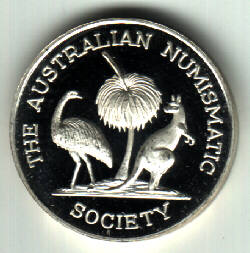
Australian Numismatic Society.
Port Macquarie Conference 12th & 13th June 2004
Editor’s Introduction.
Dear members, readers and collectors,
This issue of the Australian Numismatic Society report has been a
long time coming because it represents the documenting of all the numismatic
activities making up the biennial Mid North Coast of NSW conference.
To those of you who do not know the arrangement, the Society organises a
conference on the June public holiday weekend every second year. One of the
aims is to bring together the NSW and Queensland active members to share
their common interests and cement the society. However it has never
been exclusive and is open to collectors and numismatic enthusiasts from
all over the country and indeed any visiting international travellers.
I use the term Mid North Coast of NSW advisedly, because the NSW and Queensland
members take it in turns to organise the weekend. When organised by NSW, the
venue is a little closer to Sydney, at Port Macquarie, while when organised
from Queensland, the venue is a little closer to Brisbane, at Coffs Harbour.
Both places are delightful. While I mention it, however, discussion
at the conference proposed that perhaps we vary the format and stage the next
one in Brisbane city itself, and comment is sought on this. The advantages
are that only one group has to travel, which can be by plane and so without
the driving stress. Further there is more to see and do numismatically than
in a country town.
The conference this year was the biggest so far in the history of the ANS.
There was a full program of speakers over two days, as well as plenty of opportunity
for socialising, with a conference dinner, prize presentations, swap and
sell session, numismatic displays, and a BBQ lunch on Sunday. Full
audio-visuals enhanced the professionalism of presentation.
As you see, the amount of material was very large, and it was a big job
for one person to get the report ready. On the way, I discovered how to do
scanning with optical character recognition (OCR), which is a very useful
technology. So much so, that I am now as equally happy with well typed printed
material as with floppy disk, as input material.
Port Macquarie Numismatic Conference. June 12th and 13th.
Most members drove to Port Macquarie on Friday, arriving at varying degrees
of lateness, and the El Paso Motel, which provided the conference room venue
as well as accommodation for most attendees did a great job of catering for
guests arriving after office closing time.
Promptly at 9:00am, President Colin Pitchfork formally opened the conference,
and welcomed all present.
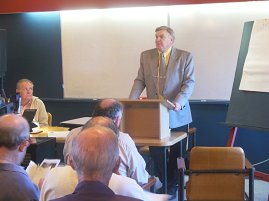
He then outlined the program and activities planned,
handing out the program and list of participants, who filled the room.
The hand out material is duplicated at the end of the report. Unfortunately,
some speakers could not attend at the last minute, so some re-organisation
was necessary. Many had organised displays, and these were laid out
in the tables around the room. Colin also supervised the handing out
to all present the conference medal, produced by the Canning mint (more later).
Apologies included Rod Sell, Jim Noble and Fred Dobbin, all who have been
very active in the society and at previous conferences. Rod in particular
was the principal organiser, but was prevented from attending by illness in
the family. He nevertheless ensured that the video system arrived, and after
a few tense technological moments, functioned very well for the whole conference.
All present were given the opportunity to introduce themselves and their
collecting interests. An observation was made, endorsed by many, that
one is born a collector.
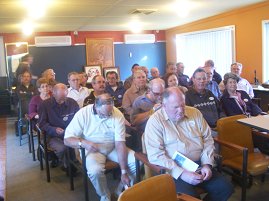
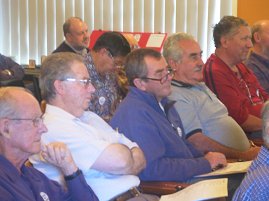
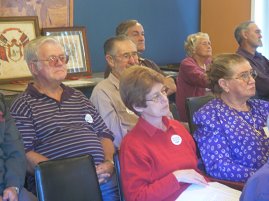
First speaker was Dr. Peter Lewis, who spoke of his experiences
in taking part in the 50th Graduate Conference of the American Numismatic
Society, held in New York, NY. The following is from notes provided by Peter:
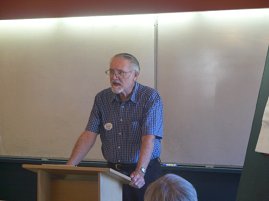
“ I was lucky. Great experience. Only 6 postgraduate
students from US universities are accepted each year, but occasionally a
foreign graduate is accepted as well. Students attending a US university
are paid $3000 to attend the 6-wk course. Because it was the student summer
holidays, I was able to stay in the student’s quarters at Columbia University,
which has a large library. New York is a great cultural centre. Given a free
pass to all museums.
Course is an introduction to academic numismatics. Full-time course. Something
everyday: lectures, discussions, outside visits. Executive Director on maternity
leave, but full time curators in Greek, Islamic and American numismatics,
and staff member expert in Roman and Byzantine numismatics. Visiting lecturers
and a visiting professor: Dr. De Callataÿ from Brussels.
ANS caters more for the academic world, whereas the American Numismatic
Association, based in Colorado, caters more for collectors. ANS has over
1 million coins in 2 vaults where there are walls of thin metal trays containing
the coins, each in a box of inert paper. There is a permanent display behind
glass windows but few visit because it is in the northern tip of Manhattan,
which has become a Hispanic area. At present the ANS is moving to a
new building in lower Manhattan, a bank building donated by a member.
ANS has the largest numismatic library in the world with full-time librarians.
Chief librarian is Francis Campbell. ANS holds conferences on various subjects
from time to time, and one on Sasanian coinage was held during the course.
ANS had a display “The history of Money” in the Federal Reserve Bank in Lower
Manhattan. ANS lends coins to the Metropolitan Museum of Art. Goal is to
put every coin in the ANS collection on the Internet. So far only 4000. Website
is amnumsoc.org.
Each student had to prepare a paper to present to the ANS at the end of
the seminar. All were PhD students except one who was an assistant
professor of ancient history. There was a German woman from Indiana
University who was doing a PhD in Islamic studies and she researched coins
of the Ilkans. A Classics student from Princeton researched Republican coins
relating to Cicero. A Classics student from Harvard researched Tyche on coins.
Other projects were the types of Faustina Junior, an analysis of recent coin
hoards of Postumus, and a study of submission postures on ancient coins. My
project was the relationship between coins and icons. Icons are religious
pictures, usually painted on wood but also made of mosaic or in other media.
Many Byzantine coins are miniature icons. On my return from New York, I stayed
in Istanbul and saw the mosaics there.
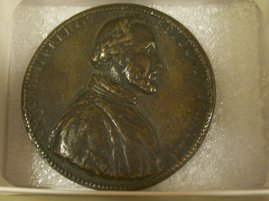
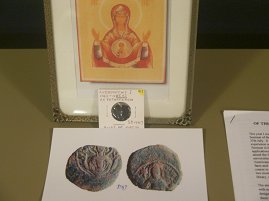
Peter showed slides of photos he took in New York and of the mosaics from
Hagia Sophia and St. Savior in Chora in Istanbul.
The next speaker was Max Bulluss, previous president of the ANS.
Max’s topic was the Colour Patches of the Australian Army.
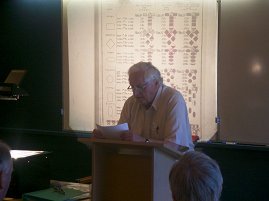
Max’s presentation was very interesting, but required concentration to follow
the various styles and additions from the relatively simpler system developed
in World War I, to the added complexities of World War II. Fortunately, Max
provided some notes on Floppy Disc (the best form, ed.), which are repeated
here as follows:
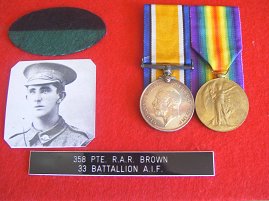
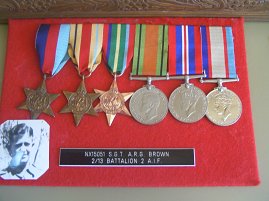
THE COLOUR PATCHES OF THE AUSTRALIAN ARMY
1915 - 1951
Since the beginning of time armies have had some system of identifying their
various units, be it by flag, shield or other emblem.
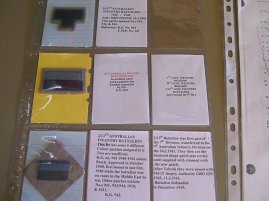
Organization of the Australian Military Forces:
Australia, during both WWI & WWII, had three armies.
Australian Military Forces was a generic term covering the three forces
consisting of the Permanent Military Force, the Citizen Military Force and
the Australian Imperial Force, which in the main was made up of volunteers
from the CMF.
Of course the 2nd AIF was distinguished from the 1st AIF by the prefix 2/
being placed before the unit and the regimental number. This also distinguished
the Second AIF from the Militia in the second conflict as the CMF had battalions
with the same number as the AIF, eg. The 4th Battalion and the 2/4th Battalion.
When WWII broke out Australian had 5 CMF divisions, consisting of 15 brigades.
Hence the first AIF division raised became the 6th Division, and so on up
to the 9th Division. As in the first war the battalions were numbered 1, 2,
3, 4 and so on, but the first brigade of the 6th Division of the 2nd AIF became
the 16th Brigade, the 17th Brigade etc.
The use of colour patches, ”coloured and shaped pieces of cloth worn on
the uniforms” to identify and distinguish various units with in the Australian
Army can be dated back to the Boer war of 1898 – 1902. “A” battery of the
Royal Australian Artillery wore a square patch, of red and white colour, on
their helmets. Even today you will note that these patches have reappeared
on the slouch hats.
Keith Glyde, author of “Distinguishing Colour Patches of the Australian
Army 1915 – 1951” noted that the colour patch system was introduced to the
First AIF in 1915 infantry battalions, artillery regiments and all the other
units making up a division, and so on up to corps level and beyond.
As mentioned above colour patches made their first appearance in 1915 when
the divisional commander of the 1st Division, probably Maj. Gen. Bridges,
decided it would be a good way of identifying the units within his command,
and by 1918 the system was adopted throughout the entire Australian Army,
from Land HQ down to the battalion level.
Lt. Gen. Sir John Monash, GOC of the Australian Corps stated that:
“The badge is highly prized by the individual soldier as the only means
of identifying him with his Unit of Service, and is a most powerful factor
in esprit-de-corps and the pride of the soldier in his regiment”.
When this system was reintroduced in 1921 into the Citizens Military Force
the soldiers were instructed to wear the patch with pride because it represented
a famous battalion or unit, which served with honour and great distinction
during the first war. During one stage, during WWI, the losses were so great
that many men were transferred to other units or battalions, and required
to change their colour patch to that of the new unit. This action almost caused
a mutiny and was only averted by allowing the soldier to retain the patch
of his old unit while serving with the new unit. “WARTIME”, the official magazine
of the Australian War Memorial records that, “The special significance of
the ‘battalion’ to the Australian infantry can be illustrated by the events
of 1918. After four years of fighting and with the strength of some battalions
below 200 men, it was decided to disband a number of battalions and unite
them with others. Fearing separation from their mates and loss of their identity
and colours after years of sacrifice together, the men refused to go. For
a time, some battalions verged on mutiny. This problem was only resolved when
the army offered a compromise that satisfied most of the men. The soldiers
went on to new units, but were able to retain the colours of their old battalions.”
The colour patch system was to remain in operation until 1951 when it was
replaced by “Titles Embroidered Shoulder” & “Signs Formation”
Development of the System of Colour Patches
Although the AIF drew its members, in the main, from the CMF it had a completely
separate identity from the PMF & Militia. All the personnel wore the ‘rising
sun”, the Commonwealth Pattern General Service Badge, on their slouch hats,
caps and collars. The metal title “AUSTRALIA” was worn on the epaulet, and
before the colour patch unit identification was also worn on the shoulder
strap.
The unit lines were identified by the use of small flags being displayed
at various spots. These flags were some 9 inches square, and produced by the
unit concerned. The colours used were green, red, and light blue for the
three brigades. The four battalions in the brigade had two colours divided
horizontally, the bottom colour being that of the brigade, while the top colour
was that of the battalion. The four colours were black, yellow, brown, and
white. Hence the 1st Battalion of the 1st Brigade flag was black over green,
so the colour patch of this battalion was black over green. The 4th Battalion’s
flag of the 1st Brigade was white over green. With exceptions, as things
changed during WWII, the 2/4th battalion of the 16th Brigade (also in the
19TH Brigade) colour patch was white over green surrounded by a grey background.
This grey background also distinguished the AIF from the Militia.
Following this the divisions raised during WWI, all had a different shape
to their colour patches. Whereas the 1st Division had a rectangular shape,
the 2nd Divisions shape was diamond, the 3rd Division was oval, the 4th Division
was round, the 5th Division was rectangular turned 90 degrees, and the 6th
Division was oval turned 90 degrees (show example).
So much for the infantry units; the Divisional Artillery was allotted dark
blue with the numeral of each brigade on the colour patch. The Engineers were
khaki with the numeral of each Field Company; Divisional Signals Companies
purple, Field Ambulance chocolate plus the numeral of the a unit. The Divisional
train was allotted dark blue over white divided horizontally.
The Light Horse Regiments had colour patches with two colours divided diagonally,
an example being the 12th Light Horse Regiment having a colour patch of black
over dark blue in a rectangular patch lying horizontally. The flag for the
1st Light Horse Brigade was white, and the colours for its regiment members
were red, light blue, green, black, purple, dark blue and chocolate representing
the 1st LHR, the 2nd LHR, the 3rd LHR, 1st Signals Troop AE, No.5 Company
AASC, and the 1st Light Horse Field Ambulance AAMC.
THE SECOND AIF
By May 1941 the colour patch system had started to stabilise itself. When
the 2nd AIF was formed the principle adopted was for the new units to use
the same colour patches as used by their similar units in WWI. Gavin Long
in his book “To Benghazi” stated “ the units would wear the patches of the
old A.I.F., but on a grey background to distinguish A.I.F. units from militia”.
The Australian War memorial provided samples of the colour patches worn
by the first mob, but due to time many of these patches had faded and discoloured.
Mistakes were made, an example being in the patch of the 6th battalion whose
real colour was purple over red, had royal blue over red.
The principal authority for producing some hundreds of drawings of the colour
patches rested with a branch of the Master General of Ordinance. One mistake
was made with this organization in that they failed to distinguish between
right shoulder and left shoulder patches; did the red go forward, that is
to the front, or did the blue go forward when the patches were bisected diagonally.
This was not a problem when the patches were bisected horizontally. One old
gunner stated that the red went first, and the blue went next, i.e. the red
represented the gun being fired, while the blue was the colour of the smoke
that came next. Another problem occurred with the 25th Brigade in England
who chose its own patches and, in the case of the 2/31st and the 2/33rd Battalions
wore patches for over five years that were quite different from the ones laid
down by the authority mentioned above. One result of this was that the 24th
and the 25th Brigade headquarters units wore patches that were identical.
However, in 1942 General Morshead obtained approval for the 9th division colour
patches to take the form of a T representing their service in Tobruk. Other
problems were the interpretations by unit commanders.
The cavalry units maintained their colours were based on the Royal Tank
Corps colours, which are interpreted as “Through mud and blood to the green
fields beyond”, brown, red and green with the brown to the front. However
another interpretation was from the rear to the front, so the patch was reversed
with the green to the front. Keith Glyde shows the Australian Tank Corps patch,
from WWI, as three colours divided horizontally with the green uppermost.
Where doubt occurred former members of the unit were invited to give an
opinion.
MINATURE COLOUR PATCHES:
The Aussie Digger was very proud of his unit, and hence the colour patch
that represented that unit. On transfer to another unit he was reluctant to
relinquish that symbol. In 1919, HQ AIF directed that personnel posted from
one unit to another could continue to wear the patch of his former unit. In
certain circumstances, where a unit was in an operational role, this could
lead to difficulty in identify personnel. To over come this problem a soldier
was permitted to wear a half size patch above the patch of the unit in which
he was currently serving. Keith Glyde records that, ”The first use of a miniature
colour patch to denote previous service with another AIF unit appears to have
commenced in the immediate post First World War period amongst returned men,
who wore a half size patch of their original AIF unit superposed on the full
size of their most recent AIF unit prior to demobilisation”.
Max Bulluss
References:
Keith Glyde, “Distinguishing Colour Patches of the Australian Military Forces
1915 - 1951”
Gavin Long, “To Benghazi”
The Official Magazine of the Australian War Memorial, “Wartime”.
Edgecombe Military Publication, “Colour Patches of the
Australian Military Forces – World War Two”.
Max illustrated his talk with overhead slides and diagrams, to make it all
understandable. Also provided was a large display showing examples of colour
patches. Reference books were on hand.
Mel Williams took the floor to present his topic on “Plants, flowers
and more flowers”.
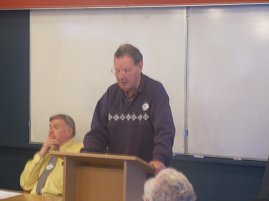
Mel’s talk was all about medals produced by or for the Royal Horticultural
Society of Queensland. The first remark was that horticultural societies were
always the poor cousins of Agricultural and Pastoral sociétés.
Not the least of their troubles were that flower shows had to be staged when
flowers were blooming. Horticultural societies existed early in the 19th century
in Queensland. In Brisbane the Queensland Horticultural and Agricultural Society
was began in 1861, but did not last as it was dominated by the acclimatisation
society. The HSQ, Horticultural Society of Queensland was formed in 1887,
although there are some records to say 1886, depending on your definition.
However it celebrated its Jubilee in 1937 and its centenary in 1986, so take
your pick. Mel contacted the current secretary of the society located
in their own premises in the Botanic Gardens at Mount Cootha, but was told
that there are “no historical records” as “secretaries change all the time”.
Mel has however found out that they went broke in the 1890s, because they
offered to pay the rail fare for all Queenslanders visiting the Chrysanthemum
show. They must have recovered because membership during Edwardian times was
over 300. In 1979 they produced a set of commemorative spoons for sale
and they have been in the black ever since.
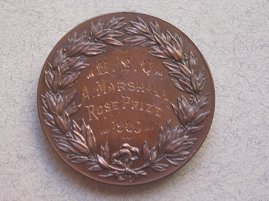
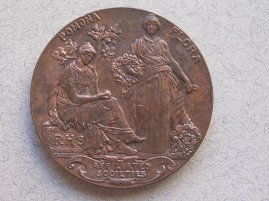
The HSQ had affiliations with the Royal Horticultural Society of London, and
could use the RHS medals. In 1935 the HSQ was granted royal patronage and
is now the Royal HSQ. It has regional societies affiliated with it and specialist
societies as well, including roses, dahlias etc. In May, 1974 a design for
a badge was approved. Mel showed the three medals that he knew of,
and said that none could be discovered for either the Jubilee or Centenary.
In 1902, a silver medal was produced for competition and greatest number
of points for roses. Then in 1903 another silver medal was awarded
to A. Marshall and a bronze medal to Mr. Ewart. In 1905 a bronze medal
was awarded to the same A. Marshall. The medals featured a portrait of Joseph
Banks and is 38mm diameter. Mel referred to other medals which he has
not seen but which should exist.
The following two sessions were allocated to Rod Sell and Jim Noble, both
of whom had to send their apologies at the last minute, so members filled
in the time with some informative mini-talks.
First up was Bernie Begley who displayed 2 decorated boomerangs
with their certificate of authenticity.
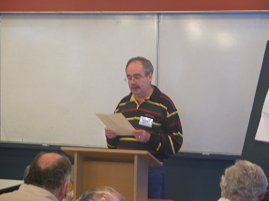
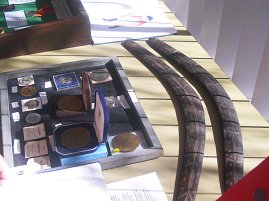
These boomerangs were of the fighting or non-returning type. Bernie said
that they were designed to fligh low and horizontally to disable the opponent
by hitting their shins. These weapons were made by tribes around the Cloncurry
- Mt Isa, Queensland area in the 1880s. They were traded for a steel tomahawk
and came from the collection of now deceased member Stewart McLeod.
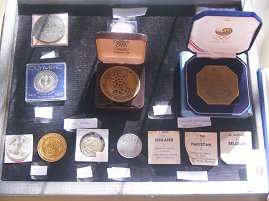
Following Bernie’s talks and display, long standing member
Roy Dunstan talked on Coins of Korea.
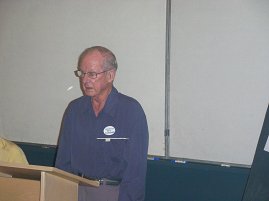
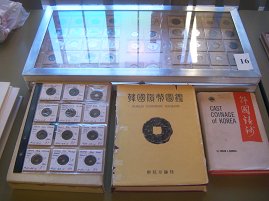
Roy told the story of how he and wife Joy (now deceased) sponsored a Korean
child, after which they visited Korea, which started the interest in its
coins. Roy firstly talked about some books, including “The cast coinage of
aKorea” by Edward Mendel, dealing with coins up till 1880 AD. The coinage
used Chinese characters until 1880 and were called Yop Chon, the equivalent
of Chinese cash. The earliest coins date from 998 AD.
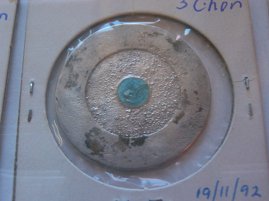
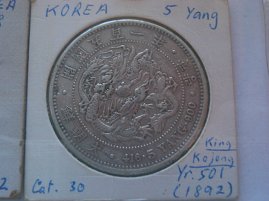
The minting authority for most of these was the Ye dynasty, ruling from
the 14th century till the 1890s, with 61 different mint locations. In 1882
King Kojong ordered the production of gold and silver coins to facilitate
international trade. In 1883 cast silver coins of fractions of a 37 gram
Korean ounce were produced with an enamelled centre in blue, black and green
each in 3 weights and given the denominations 1, 2 and 3 chon. They were
only minted for four months and not many have survived, and they are now
quite rare. In 1892 crown size 5 yang and smaller 1 yang coins were struck,
and in 1905 a half crown size was minted. From 1910 to 1945 Korea became
under the dominion of Imperial Japan, and did not issue coins, but used banknotes
instead. Not till after the Korean War, in the early 1950s did Korean coinage
enter the modern era with the monetary unit of the won. Currently $A1 buys
about 700 won.
Following a question from the floor, Ron noted that the Korean language
and script is truly alphabetic and uses 10 vowels.
NAA President Peter Lane was then invited to talk.
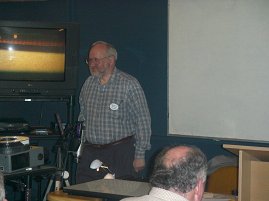
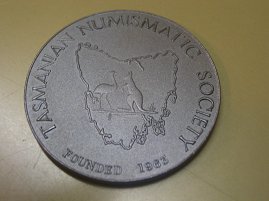
Before he began, he spoke in his capacity as President of the NAA and noted
that ANS president Colin Pitchfork had recently been awarded the Lachlan medal
of the Tasmanian Numismatic Society in recognition of Colin’s outstanding
contribution to Numismatics in Australia. The medal shows a map of Tasmania,
and the reverse is engraved with Colin’s name and award.
Peter then began his topic entitles “A Beginner’s Collection of Military
Medals”. In choosing what to collect, Peter noted that the medals of the two
20th century world wars were too close to his family, so he decide to collect
earlier medals relating to the convict period. He styles himself a
beginner as he has been collecting these medals for only eighteen months or
so.
The following descriptions are from notes provided by Peter:
“British Army Medals. For exemplary service in Australia and other parts
of the Empire and medals awarded in Australia. The early years.
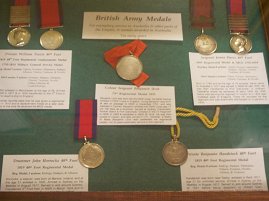
Colour Sergeant Benjamin Urch
73rd Regimental medal 1833.
Benjamin Urch was born into the NSW Corps, his father having enlisted in
the NSW Corps in England. Toung Benjamin was born at sea on passage to NSW
in December 1791, and was baptised in Sydney. Benjamin enlisted into the NSW
Corps at age 10 years, 106 days as a drummer. Served at Sydney, Parramatta,
Norfolk Island and Port Dalrymple. Enlisted in the 73 Regiment in NSW in 1809
and remained in NSW till 1814. He was then posted to Ceylon, and later
served in UK, Gibraltar and Malta. At Malter, Benjamin Urch was presented
his regimental medal – for 23 years exemplary service to the regiment.
Sergeant James Davis 48th Foot.
1819 regimental medal and MGS (Military General Service) 1793-1814.
Reg. Medal 8 actions: Oporto, Pyrenees, Salamanca, Badajoz, Albuera, Vittoria,
Toulouse and Nivelle.
MGS Medal 6 actions: Orthez, Pyrenees, Salamanca, Vittoria, Toulouse an
Nivelle.
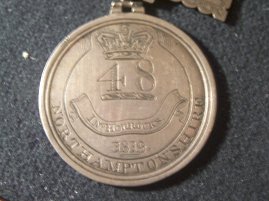
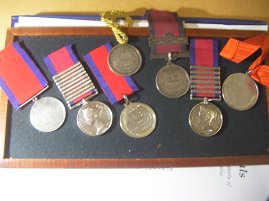
Born in 1794 and at the age of 16 enlisted. Davis came to Australia in 1817
and served in NSW till late in 1820. He was then transferred to Port
Dalrymple, in Northern Tasmania where he remained till early 1824. By 1825
Davis was serving in the regiment in Ceylon and in 1828 was invalided back
to England. There he recruited for the regiment and was eventually discharged
on a pension in 1834.
Private Benjamin Handstock 48th Foot.
1819 48th Foot Regimental medal
Reg. Medal, 8 actions: Rodrigo, Badajoz, Salamanca, Vittoria, Pyrenees,
Nivelle, Orthez and Toulouse.
Handstock was born near derby, enlisted in kent 1811, age 21 for unimited
service. Arrived in Sydney on the “Matilda” in August 1817. Served in and
around Sydney till 1821 before being detached to Hobart Town. Hanstock was
discharged there due to loss of a thumb.
Drummer John Horrocks 48th Foot.
Reg. Medal, 3 actions: Rodrigo, Badajoz and Albuera.
Horrocks, a weaver was born at Marlow, Ireland, and at the age of 31 enlisted
in 1805. Arrived in Sydney on the “Matilda” in August 1817. Served in and
around Sydney. Transferred 3rd Foot then in NSW March 1824 and in May that
year returned to England on the “Guildford”.
Private William Travers 48th Foot.
1819 48th Foot Regimental (replacement) medal.
1793-1814 Military General Service Medal.
Reg. Medal 9 actions: Oporto, Pyrenees, Salamanca, Badajoz, Albuera, Vittoria,
Toulouse and Nivelle.
MGS medal, 9 actions: Pyrenees, Badajoz, Albuera, Vittoria, Touluse, Nivelle,
Orthez, Talavera and Ciudad Rodrigo.
In 1805 enlisted in Manchester and at the age of 26. Arrived in NSW
in 1817 and in 1824 transferred to the 3rd Foot in NSW to await a ship to
England. Regimental records state that he was given a regimental medal in
1819 and a replacement medal at a later date, possibly at the time he received
his MGS medal.”
Peter also added that there were 232 medals made in Sydney by Samuel Clayton,
silversmith, all hand engraved. They were presented to members of the 48th
Foot, the NorthHamtonshire Regiment. The regiment served in the peninsular
wars, but was not in the action at Waterloo. Peter’s “beginners” medal
collection represents a lot of history and is most impressive.
After Peter’s talk, a lunch break was held. Peter’s medals formed part of
his display.
Back after lunch, David Mee (your editor) gave a talk on the Coinage
of Medieval Germany.
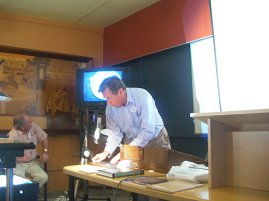
This talk was illustrated by a display of coins spanning a 1000 year time
period. It included coins of the barbaric tribes that invaded the Roman Empire
beginning in the 4th century AD. Coins of the Goths, Vandals, Franks, Anglo-Saxons
and others were displayed. These were followed by coins of the Carolingian
Franks, leading to those of the early German “Holy Roman Emperors”.
During the 12th century, German coinage separated into the traditional double
sided pennies and the :bracteates, very thin flanned coins struck on one
side only. Examples of large and small flan breacteates were illustrated.
The talk concluded with coins of the later middle ages during the period
of the florin or goldgulden, struck primarily in the Rhineland, and also
the groschen and weissphennigs , larger silver coins.
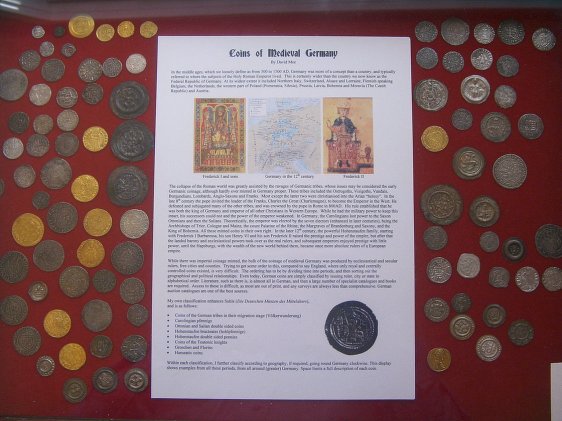
Of further interest was the collection of Hanseatic League coins, “witten”
and some multiples, from Hamburg, Lubeck, Lunneburg, Mismar, Rostock and
Stralsund. A silver shilling of the Teutonic Knights of Prussia was exhibited.
Supporting the display were other coins of the medieval “German Empire” from
Alsace-Lorraine (Lotharingia), the Low Countries and Bohemia.
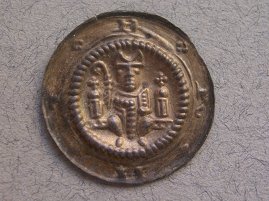
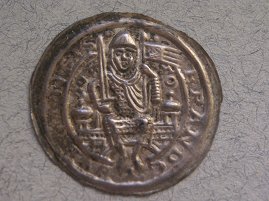
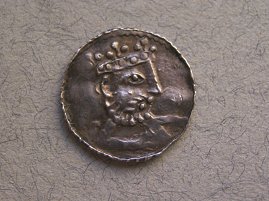
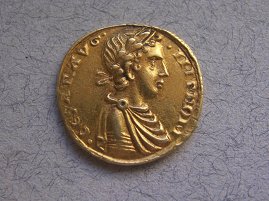
Barry Scott presented next, with the topic “The Strategy of the
Collector and the Investor”.
Barry provided the following notes which comprise his talk. He also had
on display some of his various collections.
THE STRATEGY OF THE COLLECTOR VERSUS THE INVESTOR
As a qualified accountant for well over 40 years, I help many clients by
analysing their work figures, preparing annual Profit & Loss statements
and Balance Sheets, preparing their tax returns & then working out practical
plans to save tax and improve their businesses and make some profits to help
fund their retirement. The best strategy wins and to encourage my clients
to set practical goals and work hard to achieve them. I ended up collecting
a number of success stories. A by product of this activity was my first book
"Go for your Goals" which has motivated many people to succeed in their chosen
field. I have had
a lot of fun in this fascinating area of helping people achieve their goals.
Last year, I was honoured by the A.N .S. in Qld to deliver the Vincent Read
Address and spoke about the Australian Koala Foundation which I founded in
1986.
During that talk, I explained my love of numismatics and how a teacher rewarded
me by giving me a West African tenth of a penny coin when I knew the definition
of a numismatic. An Aunt encouraged me to collect stamps and give me her Van
Dieman's land and early Tasmanian stamp sets. I entered a new world as a
collector and started collecting stamps, coins, banknotes, medals, old books
and early historical items -always learning new things and appreciating the
plucky and persevering pioneers of the past.
Between the ages of 12-20, I collected post cards, stamps, coins, first
day covers, and club memberships in athletics, swimming, bushwalking, flying
and gliding, football, cricket, tennis and skiing.
Between the ages of 21-50, I collected about 14 business degrees, flying
about 40 different types of aircraft, about 80 countries whilst travelling
around the world, women--- a wife and three daughters, and about 1100 business
clients.
Between the ages of 51- 70, I collected more stamps, medals ,coins ,banknotes,
grandchildren, old clothes, a variety of investments in real estate, shares
and paintings, many operations including a hip replacement and prostate cancer.
Life is never dull for me!
THE STRATEGY OF THE COLLECTOR
The strategy of the collector is
1. To collect what he or she enjoys.
2. To study the background of his or her hobby and
learn about the historical, religious, and period significance of what is
collected.
3. Go to auctions, fairs, web pages, collectors meetings,
fellow collectors and a variety of shops, here and overseas, to build up the
collection.
4. Communicate with other collectors and swap items
to augment your own collection.
5. Work out the best format to present your valuable
trophies.
6. Work out a budget to buy items and select key pieces
to the chosen series.
The main AREAS OF COLLECTING NUMISMATICS IN AUSTRALIA are :-
1. Proof, Pattern and Specimen coins.
2. Gold Sovereigns and Half Sovereigns
3. Commonwealth coins-halfpenny , penny copper coins,
then silver , threepence, sixpence, shilling, two shillings ,five shillings
etc.
4. Pre decimal Bank Notes.
5. Decimal Bank Notes.
6. Precious metals and bullion coins.
7. Proclamation coins as per Governor King's edict on
Nov 19th 1800.
8. Specialty collections of 1813 colonial holey
dollar and dump, 1852 Adelaide Pounds and early Australian State Tokens.
DEFINITIONS
A dictionary definition of the word "collect" is to obtain and keep objects
of similar type, because of their interest, value or beauty. Another definition
is to systematically seek and acquire books, stamps, coins etc as a continuing
hobby. Another is " to regain control of oneself after a shock! ". Maybe after
paying too much for a coin, note or medal after an auction!
I am sure you all, as fellow numismatics, enjoy your collection for the
history, the great beauty of design, the opportunity to learn by undertaking
specific research and the joy of discovering an item of value or something
which is unique.
Bernie Begley said in his 2003 Presidential address in Brisbane that "he
enjoys the ANS club for the camaraderie, the opportunity to see material other
members are good enough to bring along to meetings, to learn from others and
occasionally to share some small piece of knowledge I may have learnt". We
can all relate to these sentiments.
A definition of an Investor is someone who buys an object with the view
of making a profit on its sale. Another definition is "to devote time effort
and resources to an enterprise which should reward the person involved".
THE STRATEGY OF THE INVESTOR
Access Economics produced in the past, details of various investment classes
and their growth patterns over the last five years. They appear to have ceased
this activity over the last two years. Australian
Banknotes have increased in value by 110% during 1997 to 2002.
Coins increased in value by about 40 % during this same time. Stamp Errors
were the highest with about a 130% increase. I have personally charted Australian
Decimal Banknotes over the last 4 years using values from Greg McDonald's
9th to 11th editions. These have shown a 16% increase in this time but more
recent auction figures have shown a much higher increase, some at quite extraordinary
levels.
The role of an investor in the numismatic area has recently become more
important. In Feb 2004. Peter Costello, our Federal Treasurer, announced
new concepts in retirement in Australia. People could work longer, access
their superannuation funds earlier, and be encouraged to provide more income
for themselves, rather than relying on the support of a much younger and
smaller population of workers. Self Managed Super funds could also include
numismatic collections as part of their investment strategies.
Thus it appears that there are a great deal of advantages in being aware
of good investment strategies. Although we live in a relative young country,
Australia has produced some of the world's rarest and most sought after coins
and banknotes.
GETTING READY TO INVEST
To be successful in any area of investment, you need a strong degree of
preparation. The Monetarium Magazine had a number of good points recently.
They were in part :-
1. Become familiar with the potential and side benefits
of investing in numismatics- it helps to be very realistic with your future
expectations.
2. Acquire good resources that will support you in investing
profitably -reference books, subscriptions to magazines, a good magnifying
glass and join the ANS.
3. Set a financial objective -make it measurable
in time and value. Set a budget for a one-off investment, or the size of the
periodic allocations you will make.
4. Consider all the different ways you can sell your portfolio
-learn about alternatives. Write down your desired Exit strategy in detail.
5. Determine the time frame over which you will
hold your investment.
THE FUTURE OF INVESTMENT VALUES OF AUSTRALIAN COINS AND BANKNOTES
The value of a coin, banknote or other numismatic item is determined by
three main factors :-
1. The CONDITION of the item
2. The RARITY of the selection.
3. The POPULARITY of the series.
There are certain fashions to collect different varieties of items and any
study of recent auction catalogues will show the huge range and quality of
items that are being presented. There is also a steady DEMAND based on unusual
and rare items like the 1930 Penny, the 1923 Halfpenny, NSW Dumps, 1852 Adelaide
Gold Pounds, and the Proclamation coins. We are currently seeing a greater
than average rise in all types of numismatic items and this can be explained
by the following points :-
1. Greater public education by excellent magazines such
as Coin and Banknote.
2. Publications put out by various dealers such as Monetarium.
3. The value to collectors by joining such groups as A.N.S.
4. The disappointment of poor investment returns
from many superannuation funds.
5. The need to supplement existing investment areas
such as real estate, shares, bank deposits, with alternative numismatic items.
6. The quality and presentation of auction catalogues
prepared by Noble and Downies.
7. The knowledge and education to the public that have
come from professionally presented auctions such as Noble Numismatic Sales,
Downies Aust Coin Auctions, Edlins in Canberra, Roxburys and Colonial's auctions
in Brisbane and International Auctions at the Gold Coast.
8. The growing number and quality of World Wide Web pages
and sites where numismatic knowledge and collector lots are available to everyone.
9. Web sites such as EBid.com.au and EBay.com.
10. Exhibitions & coin and note and collectable Shows
and Fairs in our country and capital cities, further make available a growing
opportunity for collectors to learn, explore and add to their future wealth
of knowledge.
11. Publications like Greg McDonalds Aust Coin & Banknote
11th Edition and Rennicks Aust Coin & Banknote Values 20th Edition show
specific average values of numismatic items.
12. The growing professionalism of ANDA members and their
combined efforts to collectively minimize bad practices and increase education
and Public confidence.
Investment price rises or falls are based on the SUPPLY of an item and the
public DEMAND to own that item. Fluctuating DEMAND factors are as follows
:-
1. Collector's perception of the market
2. Changes in supply.
3. Changes to the monetary system.
4. Major historical events.
5. Broader events, trends, and business cycles.
6. Publicity generated by intelligent newspaper articles
and extraordinary results at recent auctions.
7. Successful investors look at the undervalued
sections of the market and position themselves before the market rises
8. They also ask themselves the question " What
do collectors want to buy in 5 to 10 years time".
So what am I?
I am an enthusiastic COLLECTOR who enjoys the study and the learning and
shared knowledge with all others in all types of numismatic collections. I
am also a keen INVESTOR who can see that a carefully put together collection
could provide wonderful and growing dividends and rewards for one's future
retirement.
Barry Scott. 123 Dunedin Street, Sunnybank Queensland. 4109. 06/06/2004.
Following Barry, George Snelgrove spoke on his topic of Ceremonial
Trowels.
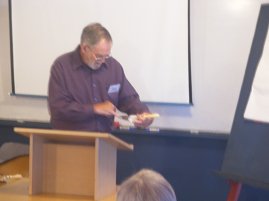
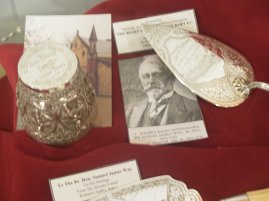
His associated display provided much interest and admiration. Numismatic
or not, these trowels represent as much history as coins and medals and are
highly collectable. George described how they came into being as special
trowels made to allow some dignitary to lay a foundation stone in a significant
building, and them being presented with it as a memento of the occasion.
They are often made of silver, or at least silver plate, and ornately inscribed.
The inscriptions of the 19th century trowels, in best copperplate writing,
are a joy to behold.
George singled out a South Australian trowel used to lay the foundation
stone of St. Steven’s church in Adelaide.
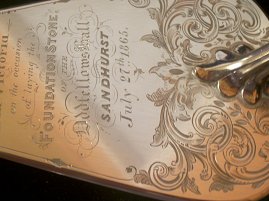
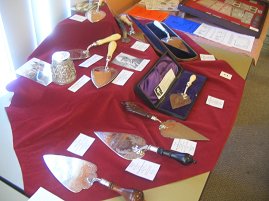
It has its inscription in German. The stone was laid by Sir Samuel James
Wey, son of the Reverent Wey who migrated to Adelaide in 1837 to found a
mission. The son trained as a solicitor, developing a large legal practice
in Adelaide and becoming a QC. He entered politics and became first
the member for Sturt, and then attorney general. In 1873 he became acting
Governor then Chief Justice of South Australia, in 1876 and Lieutenant Governor
in 1891. In 1881 he was chancellor of the University of Adelaide. He died
in 1916 and was given a State funeral. His statue in located in North Terrace,
Adelaide, dedicated in 1934.
Two other trowels in George’s collection were also associated with Sir Samuel
Wey.
Following afternoon tea, Ken Sheedy presented his talk on The Early
Coins of the Aegean Islands, illustrated by slides from the British
Museum.
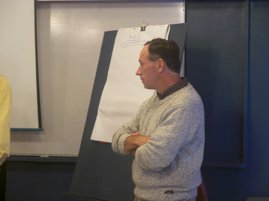
The Aegean Islands were the place of production of some of the earliest
Greek coins, beginning with the second half of the 6th century BC.
Two coins from the Isalnd of Chios were illustrated, one from the town of
Kathea showing an amphora and a dolphin, and the other from the town
of Karezos depicting a cuttlefish and dolphin.
Ken remarked that the deep punch marks common on early coins was used to
indicate that the coin was of good silver all the way through.
Slides of 3 coins from the island of Syphnos depicting an eagle and the
hand of Apollo were shown. Syphnos is the only Greek island with metal rich
ores and caches of bullion may have been expected to be found, but in fact
only small local coins have turned up.
The island of Paros featured a goat, a symbol of Demeter, on its coins.
A slide of a 12.2 gram stater was shown, with a dolphin below. Paros was
the centre of a cult of Dionysos, but no evidence of this has been found
on the coins. An image of another coin with a stick like goat figure was
shown, with Ken noting that this was part of a very large issue around 520-500
BC.
An slide of a coin of Thera (modern day Santorini) showed two dolphins swimming
in opposite directions. Other images showed coins one with the head of a satyr
and the other a gorgon.
The island of Seraphos is famous for its coin depicting a frog. The specimen
in the British Museum was unique in the 19th century. Since then over 25 have
since been found, and all are considered forgeries, except the BM example.
It is believed that all were copied from the BM example. They have been struck
over worn Aegina turtles, and hence have the correct metal and weight.
The island of Melos means Apple isle, and its coins depict an apple.
The famous Melos hoard was discovered by children in the 19th century.
A stater from the island of Naxos, which is the richest of the islands of
the Cyclades with good soil, depicted Dionysos and a Kantharos (wine cup).
The next speaker was John Cook from Queensland whose talk was entitled
“The Trials and tribulations of the 500th meeting medal for Queensland.”
John supplied a file on floppy disk covering his talk, which is reproduced
below. There were no images in the file, as seem to be implied by the text,
so the file has been re-formatted slightly to remove white space.
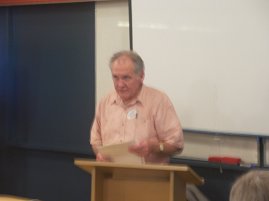
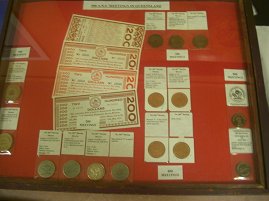
THE AUSTRALIAN NUMISMATIC SOCIETY
Port Macquarie Biennial Conference 12th and 13th June 2004
The Trials and Tribulations of the Queensland 500TH Meeting Souvenirs
In late 2003 the Committee decided to proceed with a numismatic souvenir
to mark the occasion of the forth -coming 500th meeting in May 2004. John
Cook and George Snelgrove set out to achieve the Committee's wishes.
It was suggested that we use a 1962 Australian penny; this was the year
of the first meeting in Queensland.
The penny was to be suitably engraved with details for the occasion.
We had recently been to A J Parkes and we had seen some aspects of badge manufacture
where colours had been applied to badges. Naively, we thought that we might
be able to incorporate some of these procedures in our project.
Initially three trial pennies were engraved to gauge the desired effects.
Type 1 – On the Kangaroo side – engraved "Australian Numismatic Society
Qld Branch 1962 - 2004”.
The other side was not engraved. Attempts were made to colour in the engraving.
Type 2 – Larger engraving with a burred engraving and some blue colouring
applied. This example was encroaching on the existing date.
Type 3 –Another attempt to eliminate the burring with another engraving
tool met with no more success.
It was then decided to abandon the colouring of the engraving. With the
assurance of the engraver that we would finally get a suitable result, we
decided to tone the pennies to basically one colour and rely on the engraving
to give a contrast.
Then the tribulations began!
We had used or heard of “liver of sulphur” in the distant past but on enquiries,
I was told that it was no longer available due to environmental concerns.
Some considerable time was spent talking to pharmacies, electroplaters and
their suppliers. My partner, who had served his time with Whitco, was even
coopted to recall his knowledge on the subject of the plating processes. At
one point a sulphur and olive oil solution was tried with a disastrous result.
Type 4 – Very badly sulphur stained coin.
At long last we obtained a liquid from an electroplating shop which we were
assured would give us the desired result. After a full day, again our
hopes were dashed. Try as we may, we could not get the toned effect we required,
hence Types - 5a, b, c, d and e.
In desperation we resorted to trying to paint the surface of some
coins Types 6a and b without success.
Again more phone calls. Eventually someone suggested that we may be using
the solution at full strength. On the first attempt at adjusting the mix,
we were getting somewhere! After several more hours of toil, we were relieved
to find that we had discovered the secret Type 7 - Obverse and reverse.
Then onto the engraving. Whilst considering the design positioning to preserve
the date on the host coin, and procrastinating at length, Vanessa Snelgrove,
George's sixteen year old daughter, suggested that we have the “COMMEMORATING
500 MEETINGS” on the reverse. Another problem solved!
The engraver then experimented resulting in Type - 8. The date on the obverse
needed re-positioning and we felt that the "500" could be larger. Types 9a
and b.
Although the engraver thought he had saved both layouts, he could not retrieve
the "500" layout, resulting in him producing Types 10a and b which were
in fact errors. He wrongly presumed that we intended to have this year's date,
2004. It should have been 500 which he realised himself and went about correcting
it to produce the final Type 11.
The bulk of the coins were then put in for engraving. After delivery,
we lacquered both sides to preserve the contrast of the engraving against
the toned host coin.
For future reference, we experimented with having bright samples engraved,
painted samples engraved and engraved samples toned.
The illustration in the booklet differs to that of the one on the cover
because we used Type 9b to illustrate in the early stages of production of
the publication. The cover illustration was taken from a scan of Type 11.
This was not realised at the time. The souvenirs were presented in a plastic
flip with a small descriptive insert.
500 A.N.S. MEETINGS IN QUEENSLAND
The 100Th Meeting
ObverseLegend: AUSTRALIAN NUMISMATIC SOCIETY BRISBANE BRANCH
ReverseLegend: MEMENTO OF ATTENDANCE 100 TH MEETING 20 TH JAN. 1971
Size: 33mm
Maker: ANS Members
Material: Qld Beechwood
Mintage: 33
The 200Th Meeting
Obverse Legend: AUSTRALIAN NUMISMATIC SOCIETY
ReverseLegend: TO COMMEMORATE THE 200 th MEETING OF A.N.S. BRISBANE MAY
1979
Size: 35mm
Maker: Amor
Material: Aluminium
Mintage: 100
Material: Silver
Mintage: 3
Edge stamped “S” to signify specimen
The 300Th Meeting
ObverseLegend: AUSTRALIAN NUMISMATIC SOCIETY
ReverseLegend: A.N.S. BRISBANE BRANCH QUEENSLAND 300 TH MEETING
20 TH YEAR COMMEMORATIVE DINNER
Size: 35mm
Maker: Amor
Material: Bronze
Mintage: 100
Edge stamped “S” to signify specimen
The 400Th Meeting
ObverseLegend: AUSTRALIAN NUMISMATIC SOCIETY QUEENSLAND BRANCH
ReverseLegend: A.N.S. QUEENSLAND BRANCH 400 TH MEETING CELEBRATED ON 18TH
JANUARY 1996 BC
Size: 32.9mm
Maker: Canning Mint
Material: Copper
Mintage: 50
Stamped “S” on the reverse in the field above 400 to signify specimen
Following John’s talk, Ron Bolden presented his session. Ron’s notes are
reproduced below.
Presentation by Ron Bolden at Australian Numismatic Society Conference
at Port Macquarie on Saturday 12th June, 2004
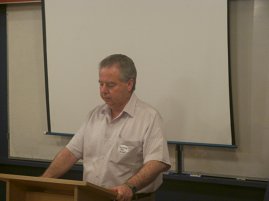
The Coins of the Passion ……. 30 pieces of silver
I would firstly like to expand on the title to clarify what I am speaking
about. The 'passion' is the Passion of Christ which has been recently highlighted
by Mel Gibson's film of that name. The dictionary defines the passion as "the
sufferings of Christ on the cross, or his sufferings subsequent to the Last
Supper" and "the gospel narrative of the sufferings of Christ, as in Mark
14 -15 and parallel passages in the other gospels."
Those of you who are keen gardeners will know; and others will be disappointed
to know that the passionfruit is not an aphrodisiac but is so named because
some people have seen in the flower supposed resemblance to some aspects of
the Passion, such as a cross in the middle.
The "thirty pieces of silver" refers to the money Judas Iscariot was paid
to betray Christ to the authorities. This is referred to in Matthew 26 : 14,
15 where it says 'Then one of the Twelve -the one called Judas Iscariot -went
to the chief priests and asked "What are you willing to give me if I hand
him over to you ?" , So they counted out for him thirty silver coins.
How do we know which silver coins were being discussed ? It is generally
accepted by scholars that the coins were shekels of Tyre. This is because
at the time the Jews did not have silver coins of their own and the Temple
treasury only accepted silver of high purity and guaranteed weight. As well,
in the Jewish Talmud there is a direct reference to the Temple coinage being
Tyrian silver. It is also backed up by archaeological evidence.
So where was Tyre? Tyre in ancient times was an important Phoenician trading
city on the Mediterranean coast. Originally on both the mainland and a close
off-shore island it came to be concentrated on the island which was more easily
defended. In 332 BC Alexander the Great in a famous campaign laid siege to
the city for seven months and finally overcame it by building a causeway.
Ancient Tyre has a long and very interesting history which we don't have
time to explore here. There are good internet sites to explore, but don't
forget to put some qualifying words with 'Tyre' in the search engine. Otherwise
you may find yourself becoming expert in the products of Dunlop, Goodyear
and Bridgestone. In modern terms the city is about 83 km south of Beirut
in Lebanon and called Sour. The causeway has now expanded into a half-mile-wide
peninsula. Let's now return to ancient times.
The moneychangers in the Temple precinct whose tables Christ overturned
did in fact have a role to play. There was a range of currencies in circulation
including Greek, Roman Provincial and Jewish. To these locally used currencies
would be added coins brought by Jewish pilgrims who came from places all around
the known world. These traders charged around 8% to change these currencies
into Tyrian shekels. However some commentators have suggested that the area
had become something like the trading :floor of a stock exchange with dealers
calling out their rates. They suggest it was not the role they played but
the way they carried it out that Christ objected to. He was reminding them
that the Temple was a sacred place of worship and not a place to conduct rowdy
business.
It might be wise at this stage to point out that the Old Testament references
to shekels were to a known weight of silver rather than a coin, and later
became a denomination. Some of these Old Testament references may be seen
in my display. In the old British system we have an example of this where
the pound was both a weight and a denomination. In the cartwheel penny which
weighed one ounce we have a correlation between a weight and a denomination.
Also when the gold price was fixed, the weight of gold in a sovereign was
a denomination.
Now onto the shekels themselves. The obverse features the laureate head
of Melqarth, the city god of Tyre, facing right. He wears a lion skin knotted
around the neck; however this feature is usually only seen on large flan coins.
The Greeks equated him to their Herakles who was in turn the Roman Hercules.
The reverse features an eagle with right foot on a prow of a ship and palm
branch over right shoulder. The inscription in Greek reads 'of Tyre the holy
and inviolable'. In the field to left is a club (a symbol of Tyre) and a
date in Greek letters. In the right field there are Greek letters or monograms.
The shekel weighs approx. 14 grams and the half shekel 7 grams. This type
was issued from 126/5 BC to 69/70 AD.
The earlier issues were on large flans with good engraving. Over the years
there were changes in style and fabric. However from 18/17 BC there was quite
a dramatic change in the style and fabric. The style is generally inferior,
the flans are smaller and dumpier and the inscriptions are sometimes barbarous
and partial. The letters KP also appear in the right field. The very last
pieces which overlap with the Jewish War or First Revolt against the Romans
are very rare.
Dr Ya'akov Meshorer, one of the most highly respected scholars in ancient
Jewish numismatics, considers that this change represents a shift of minting
from Tyre to Jerusalem. Dr Brooks Levy, curator of coins at Princeton University,
in a 1991 paper challenged Meshorer's theory about this change. Both scholars
agree in general about the changes in style and fabric but differ in their
interpretation. There is some archaeological evidence to support Meshorer
with hoards including the earlier shekels tending to be found in modern Lebanon
and Syria and the later style ones in Israel. Considerable discussion has
followed and the matter is still not resolved.
I would now like to discuss the letters 'KP' in the right field of these
later shekels.
Meshorer suggests that the 'KP' might be an abbreviation of the Greek KPATOΣ
-
'power' or 'authority' or Greek words meaning '(according to the) Roman
constitution'. Levy thinks it could be an abbreviation for KAIΣAP -'Caesar'.
These proposals are at best educated guesses. Since the experts can't agree
I would like to propose a new explanation. What if the letters 'KP' are in
fact numbers and not letters. 'KP' translates to 120. If you add 120 to the
18 BC when the altered style shekels appeared, you get 138 BC. 138 BC just
happens to be the accession year of the Seleucid King, Antiochus VII. It was
Antiochus VII who wrote a long letter 'to Simon the high priest and ethnarch
of the of the Jews, and to the whole (Jewish) nation'. This letter is recorded
in I Maccabees 15, one of the books of The Apocrypha. This letter reads in
part 'I permit you to mint your own coinage as currency for your country”
.Is it just possible that in minting shekels in Jerusalem, the Jews were alluding
to the fact that they had in fact been given permission to mint coinage of
their own 120 years earlier. Please remember where you first heard this theory.
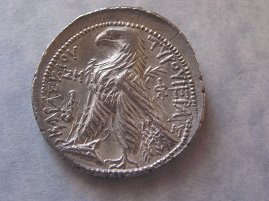

Ron’s talk was the last scheduled for Saturday. The talks were wound
up for the day and a less formal agenda followed. This included the buy, swap
and sell session from 5:30pm, which saw members with their little trays of
items for sale and swap and also active buyers and swappers out in force.
Following that, the meeting retired to prepare for the society dinner, held
in the dining room of the motel at 8:00pm.
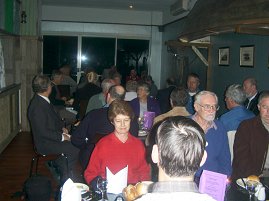
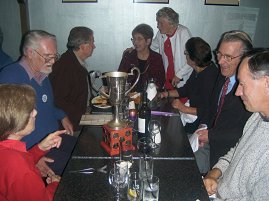
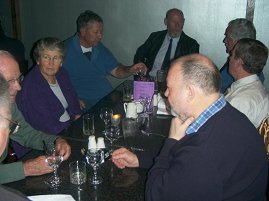
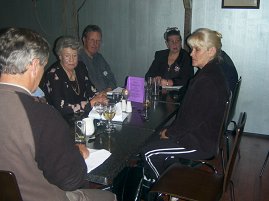
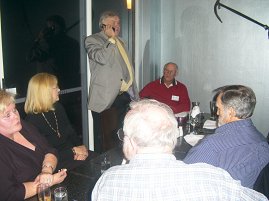
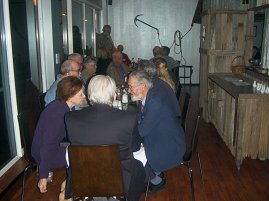
Following an excellent meal, the highlight of the evening was the presentation
of the Tom Hanley cup, awarded for the best numismatic publication by
members for the previous year.
The award was given jointly to Peter Lewis and Ron Bolden for their book
“The pocket guide to Saint Paul”, published by the Wakefield Press. Appropriately,
the presentation was given by Mrs. Joyce Hanley.
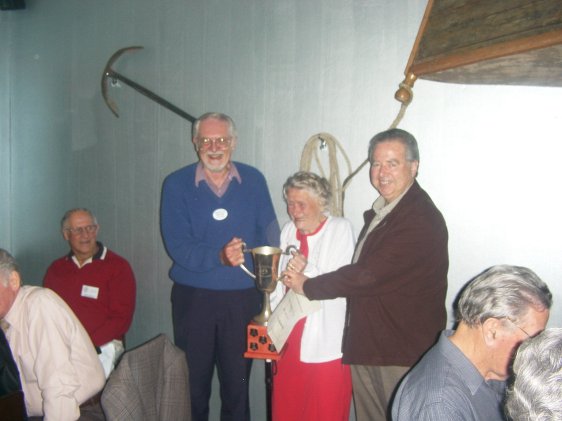
On Sunday morning, councillors from NSW and Queensland started at 8:30 with
a joint council meeting to discuss items of interest and policy. These rare
joint meetings are the only time that each group meets face to face. Rod Sell
was missed, but nevertheless, Rod had prepared the agenda which was followed.
One of the main topics was the venue of future conferences, with some members
believing that either Sydney or Brisbane might be better than a country resort.
This was to be put to members for consideration.
At 9:00 am the formal talks recommenced, with President Colin Pitchfork
giving his talk on Cistophoric Coinage. The following reproduces
Colin’s printed notes.
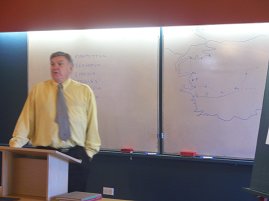
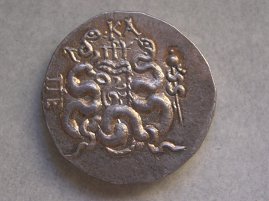
CISTOPHORIC COINAGE
For two hundred and seventy years this coinage known to ancients and modern
as cistophoric has been discussed by numismatists and historians without a
clear consensus being achieved as to when the coinage began.
This unique and unusual federal coinage was introduced into Western Asia
Minor as the result of a monetary union among several cities.
The city of Pergamon was the dominant city in this union, and the coinage
commenced by introducing a unique weight standard.
It was initially introduced as a Royal Coinage that was designed to create
a monetary monopoly for the Attalids in Asia Minor. It continued for over
three centuries with nearly two of those
centuries being controlled by the Romans.
Modern study of this coinage began in 1734 when A.X. Panel published De
Cistophoro and he identified the silver tetradrachms weighing about 12.5
grams and bearing a mystic cista within an ivy wreath on the obverse and
a bow-case entwined by serpents on the reverse with the cistophori mentioned
by Livy, Cicero and Festus.
His views on the nature of the coinage (linked to festivals) was rejected
by Eckhel in 1794 who stressed its commercial importance and the advantages
of several cities issuing coins of uniform weight and type.
The first -and only -corpus was published by Pinder in 1855. He believe
about 133 B.C. and this was endorsed by Theodor Mommsen. Mommsen also believed
that this was the coinage of the Province of Asia and sought out reasons why
in terms of Roman convenience (maybe as he felt it equalled three denarii)
and the Romans would not permit Attalid king civic issues in silver in large
quantities.
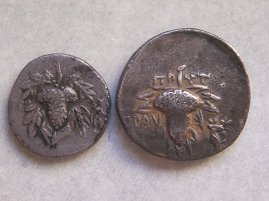
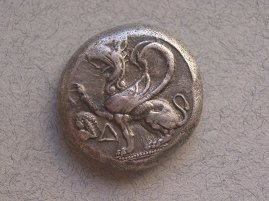
Other numismatists felt that Livy was correct in his statement and that
the coinage began about 200 BC (Lenormant in 1867) in Mysia at Pergamon
and several other cities and expanded after the enlargement of the Attalid
kingdom. It success was also felt to be that its unique weight standard allowed
four cistophori to equal three Attic tetradrachms ( @ 17 grams) .
Head, in his Coinage of Ephesus in 1880, felt that because of the number
of dated cistophoric coins from Ephesus known, that the coinage began well
before 133 BC. He placed this date as
159BC and was perhaps on the occasion of the accession of Attalus II and
attributed the idea to Eumenes II, a decision supported by the Romans. Head
believed the issue place the Rhodian coinage of similar weight in the Eastern
Mediterranean. It also accelerated the decline of Rhodes after the creation
of a free port at Delos in 167 BC.
Imhoof Blumer entered the discussion and because of a specific issued with
the BA EY n the coins linked the issue to king Eumenes and dated the
issue as 188-186 BC. And since they were well into the series of issues he
felt the issue began at Ephesus in 215-210 BC. His solution restored favour
to Livy’s statements. This was the position until 1950.
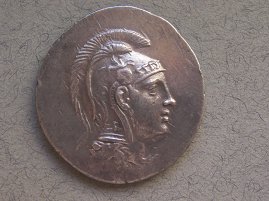
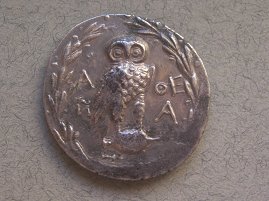
In 1950 S.P. Noe published his reappraisal of the evidence for the beginning
of the cistophoric coinage. He showed that the issue was closely associated
with Pergamon -the cista mystica
Itself, the grapes and ivy leaf of the few fractions struck are allusions
to Dionysus, a deity highly regarded at Pergamon.
Both Imhoof Blumer and Noe based their arguments on a common premise that
there existed
dated cistophori from the early years of the reign of Eumenes II but this
changed in 1954 when E.S.G. Robinson established the view that they were not
related to Eumenes II and the EA BY series was more about 132-130 BC (issue
of pretender Aristonicus).
Robinson believed the cistophori replaced the regnal coins. He believed
if the date of the last Philetaerus could be determined the beginnings could
be established for the cistophoric coinage.
Westermark in 1960 published her thesis and established the end of the Pergamene
coinage as 190 BC. She could not say however when the coinage began.
Seyrig renewed the debate in 1963 and concluded that the cistophoric coinage
replaced the Pergamene dynastic coinage in 188 BC.
Kraay also endorsed this view with the qualification that the cistophoric
coinage was not a fed- eral currency but the regal coinage of the kingdom
of Pergamon.
Christof Boehringer also argued for a 190 BC start, but this was only very
temporary and the main revival began again in 164 BC.
A new hoard of 752 coins from Mektepini reduced the date of the last issues
of the Pergamene kings to about 180 BC. In addition hoards buried in the decade
150-140 BC contain many varieties of cistophori. The evidence suggested to
Kleiner in 1977 that these cistophori were introduced before 160 BC.
Historical evidence (Galatians ravaging Pergamene territory in 168 BC) forced
At talus II to seek help from Rome. The Romans refused to help and this further
encouraged the Galatians.
Eumenes himself was very concerned and this caused him to journey
to Rome for Roman support but he was not allowed to enter Rome. He returned
and without Roman support defeated the Barbarians. It was this time that Eumenes
emerged as the champion of the Greeks. Polybius called Eumenes the greatest
royal benefactor to the Greek cities of his time.
The Attalids claimed descent from Dionysos and Heracles and new types of
coins celebrating these deities seem perfectly appropriate. Cities such as
Ephesus, Tralles and Sardis inaugurated religious festivals in honour of Eumenes
and expanded the coinage to these places as well.
The new coinage that commenced about 166BC had a weight standard (12.6 grams)
equal to 3 Attic drachms and 3 Roman denarii.
This new currency and its exchangeable weight with more universal coinage
made its local acceptance easy. It did not become an international coin but
was strictly a local coin for local circulation over the western area of Asia
Minor and rarely found outside the Pergamene territory. Foreign coins are
almost unknown in hoard finds.
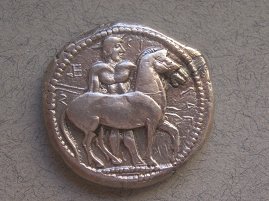
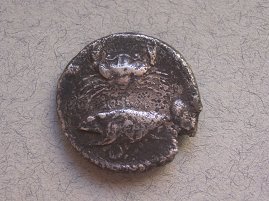
Morkholm entered the debate in 1979 to revise the start date back to 175
BC and argues this date successfully but this again is refuted in 1980 by
Kleiner.
The matter rests as Kleiner wrote in 1977 as commencing in 166BC.
Its finishing date however is much easier to establish. Kleiner in Museum
Notes 18 (1972) & 23 (1978) examined the post 123BC coinage. Ephesus was
significant as it has a dated coinage to year 68 corresponding to 68-67 BC
and date from the formation of the Province of Asia in 134- 133 BC.
In this dated series Pinder knew of 24 dates, Head added 11 more dates,
Kleiner added another 7, making a total of 42 of the 67 dates.
I have added another 7 more dates from my collection from year 20 to 42
these are all new and unlisted and in my collection.
The Pergamon series carry magistrate names as initials or monograms and
Kleiner has arranged on hoard evidence the periods of issue again ending
in 67 BC. I have three more new pieces to fit into the series.
The six known published hoards yield 450 coins prior to 123BC and after
123BC a further 9 hoards yield 400 coins.
About the year 2000 another major hoard was found containing about 750 pieces.
This hoard was buried about 88BC.
I obtained about half the hoard and added new varieties to my collection.
The remainder are with several collectors and stock of the company Noble
Numismatics.
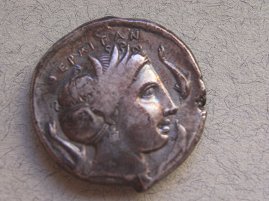
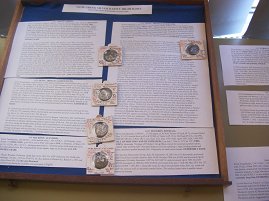
After Colin, John Veltmeyer followed with a talk on “Farthings”.
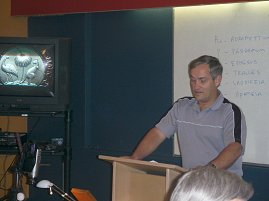
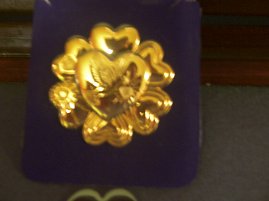
John began with the note that the term was derived by cutting silver pennies
first in half, to make halfpennies and then again to make “fourthings”, a
practice occurring before 1279 AD in England. From that date, under Edward
I a round farthing coin was minted and regularly produced thereafter up to
the time of Edward IV in the 15th century. There were, however, expensive
to produce and “fiddly”.
James I (VI of Scotland) granted a license in 1613 to produce tin washed
copper farthings first to Lord John Harrington whioo dies in 1614, then to
the Duke of Lennox, who died in 1624 but became the Duke of Richmond under
Charles I. The “Richmond” farthings have a harp reverse. Because of
extensive forgery, a new design was produced with a brass plug, and a rose
reverse.
In 1672 regal farthings with Britannia reverse were produced, and in 1674
they were made of tin with a copper plug. The tin farthing was continued under
James II and William and Mary until 1692. In 1694 a copper farthing was produced,
which tradition continued till 1860, when bronze was used. Under Queen Anne
a one year type was issued. Under George I annual issues were made and George
II continued the issues most years. In 1799, Matthew Bolton minted a farthing
for George III with the word “Farthing” on it. George VI. William VI
and Victoria in the early years of her reign minted copper farthings of diameter
22 mm featuring Britannia with a lighthouse and ship. When bronze farthings
were introduced the diameter was reduced to 20 mm, with a similar weight
to the Australian one cent coin. On the old head Queen Victoria issues
the lighthouse and ship were removed, and this was continued under Edward
VII and George V. In 1937 a new design was issued under George VI, featuring
a wren and the word “farthing”. Under Queen Elizabeth, the wren was
retained but the word “farthing” was removed, with the last issue being in
1956 when it was de-monetarised.
Following John’s talk, Colin Thomas presented a talk on Cooperative
Tokens,
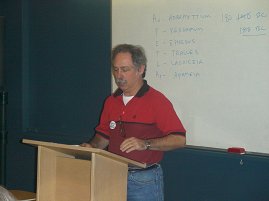
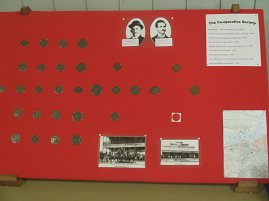
with particular referenced to his display. He began by discussing
the Royal Arsenal Coop tokens of which his display featured a range from
halfpenny through to five pounds. The principles on which the coop operated
were: no credit, non-religious, bonus sharing, with dividend in tokens and
honest trading. From this coop, in 1863 the CWS, or Cooperative Wholesale
Society was founded. In 1867, insurance was added to the activities and in
1877, manufacturing, shipping and banking were included. In 1895, the first
international congress was held. In 1900 it is recorded that more than 1000
cooperative societies were active around the world (compared with about 45
today).
Colin noted that the Kurri Kurri cooperative society began in 1904 as an
affiliate of the British Royal Arsenal Society. Youth clubs were also a feature
of the coop societies.
Following Colin, Les Carlisle’s topic was “Thomas Stokes, business
builder”.
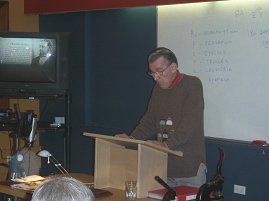
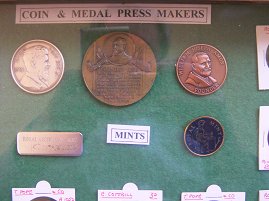
Stokes founded a business in colonial Australia as an engraver, die sinker
and producer of medals and tokens. His first business began in 1855 in Collins
Street, Melbourne. It was a partnership until 1895, when fire destroyed the
premises. It became Stokes and Son until 1910, when it became Stokes and Son
Pty Ltd, which it remained until 1965, and then Stokes Australia Limited under
modern owners. The location also moved, from Collins Street, first
to Brunswick and then to Ringwood in outer Melbourne, where it still operates.
Thomas Stokes was born in Edgbaston, England and came to Australia aged
23. He had training as an engraver and die sinker. He went to the goldfields,
but met little success there. He began initial employment as a carpenter.
His entrepreneurial spirit soon took over and with some capital he invested
in a striking machine which he took to public exhibitions. He teamed with
W J Taylor to form the Port Philip Kangaroo Office and made dies for 2, 1,
½ and ¼ ounce pattern coins. Two of these dies are now in the
Victorian Museum, and the other two remained with the Stokes business at least
until 1917.
Les said that he has been allowed to view a lot of the Stokes archival material,
including being allowed to photocopy and make notes etc. Some early
material is missing, believed destroyed in the fire of 1895. This material
included early advertisements, embossing machines, dies for local council’s
coats of arms and dies for Agricultural Society medals. Stokes employed Hogarth
and Ericksen to engrave dies. Julius Hogarth became bankrupt after he split
with Ericksen and then went to Melbourne to work as a contractor to Stokes.
Thomas Stokes was the first in Australia to deploy electroplating, using
a (lethal) mixture of silver nitrate and potassium cyanide, with a battery
and silver electrode.
Stokes made the original “Rising Sun” badge in 1902. Originally, the
sun’s rays were meant to represent the states of the new commonwealth, with
a crown in the centre. When WW1 began, the rays became bayonets, as a trophy
of arms. E W Cole, of Coles book shop fame was a major customer of Stokes.
In 1879 Coles issued his first token and paid 10 pounds to Stokes for a pair
of dies.
Stokes was also the manufacturer of a prototype shearing machine, patented
in 1877. It was the catalyst for the formation of the Australian Labour Party
and the shearer’s strike of 1891.
Stokes attended exhibitions in Europe: Paris in 1889 and London in 1899.
He exhibited coin presses, dies and blanks at the exhibitions, as part of
his marketing. He attended the Eiffel Tower exhibition.
Over 150 years of history of commercial production of coins, medals and
tokens is embodied in the Stokes business archives. Les showed a horse medal
engraved by Julius Hogarth and a pamphlet with the explanation of the operation
of an embossing machine.
Following Les, the formal talks were suspended so that the member’s
displays could be discussed and voted on. At biennial conferences,
members are invited to submit a pre-prepared display of their treasures. Members
vote on who has the best display, for which a small prize and medal is awarded.
This year, two books were donated by John Downey for the first and second
places. The displays were arrayed around the meeting room on tables
at the beginning of the conference, so most members had plenty of time to
study them. However, to further explain, each exhibitor was given the opportunity
to talk further about his or her display. Many previous speakers had already
referred to their display in the formal talks, but this did not prevent them
from further expanding on their enthusiasms.
The exhibitors and their displays were as follows:
1. John Cook, with a display of souvenir medals produced
for the 100th, 200th, 300th anniversary meetings of the Queensland Branch
of the ANS. The display also included a wooden souvenir, aluminium pieces
from Amors with edge stamped S, denoting specimen.
2. George Snelgrove, with his display of presentation
trowels. George pointed out several favourites, including a 1927 trowel
for a Mrs. Blue, to lay the foundation stone for her residence in Cremorne
in 1927, a trowel for a hall in Uralla, NSW in 1888, one for the Oddfellows
Hall in Bendigo, Victoria and one to a VC winner (Towse) from the Boer war.
3. Colin Pitchfork had an exhibition of Greek coins, being
some of the highlights of his extensive collection. He noted that each coin
had an ancient story to tell, and a modern pedigree as well. Among the
coins were a tetradrachm of Akragas in Sicily, one from Akanthos, a coin of
the Potidiae and Skione in Macedon, an octodrachm and drachm of the Bisalti,
a Macedonian tribe and a fine archaic tetradrachm from Abdera, with a long
pedigree from many famous collections and sales.
4. David Mee discussed his display of the coinage of medieval
Germany, drawing attention to particular coins of interest and the relationships
both geographical and political of each to the others. The coins on display
ranged from the early Germanic barbarian tribes to those of the Holy Roman
Emperors, the counts, bishops and cities of Germany in the later middle ages.
5. Les Carlisle discussed his display of medals, and medal
press makers.
6. Ron Bolden’s display was based on his previous talk
on the 30 pieces of silver, that is the Tyrian Shekels.
7. Colin Thomas’s display showed the various tokens of
cooperative societies as discussed in his talk.
8. Garry Green discussed his display of Olympic badges
and medallions, including those issued by sponsors. Among his items were a
volunteer’s medal from Amsterdam in 1928, and items from Munich in 1936, Melbourne
in 1956, Los Angeles in 1984 and Calgary (winter Olympics) in 1988.
9. Peter Lane’s display was of his fine collection of
early colonial service medals as per his earlier talk.
10. Nerida Bulluss talked about her display of Legacy
items. She talked of two brother and two wars, where both died from
war related wounds or diseases, the elder in the first war and the younger
in the second. The display included an illuminated address.
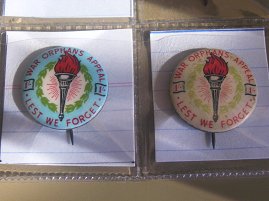
11. Peter Lewis’s display illustrated his talk and included
a recent acquisition of a fine Renaissance medal.
12. John Veltmeyer’s display focussed on the heart badges
produced to raise money for children’s charities by the Variety Club.
13. Alex Rintoul produced a display on the Euro but unfortunately
had to leave before he could present it. He left the notes of his presentation
with the editor and these are reproduced elsewhere in the report.
14. Roy Dunstan’s display was his items from Korea, as
discussed in his talk. He noted that the Korean language has 40 distinct phonetic
sounds and a special phonetic alphabet was designed to represent it in symbols.
15. Barry Scott’s display was a collection of collections,
presented in albums. It included German notgeld, farthings and gold leaf banknotes,
among others.
Following the display presentations, the meeting adjourned to a poolside
BBQ lunch provided by the society (and the motel management). 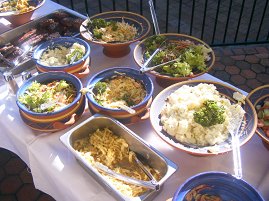
Sitting in the wonderful weather among friends with similar interests and
sharing an excellent meal ensured a memorable occasion.
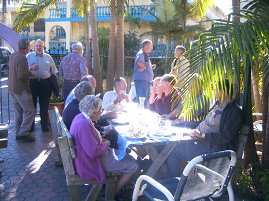
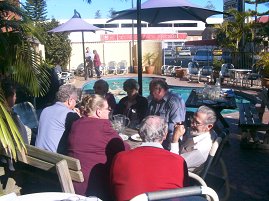
Reassembling after lunch, the meeting was treated to Bruce Canning’s
demonstrations and discussions about his minting methods.
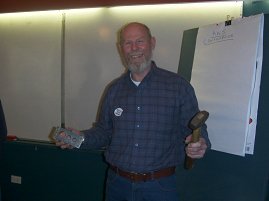
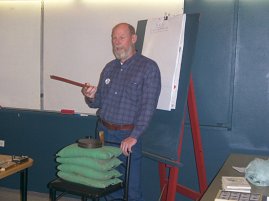
Bruce described the process for minting medals, starting with, for example,
a copper strip, which is first heated and cooled to make it as soft as possible.
Following that, it is polished and then a cutting tool (like a cookie cutter)
to strike out round blanks, using a hammer. A special cutter is used
to cut a hole in the middle of each blank, so that neither the ring nor the
“dump” is distorted by spreading. Any burrs are filed off, and then,
using a wooden tool to hold the blank, steel wool is used to re-polish the
surfaces. A strip of aluminium was also used to cut “dumps” so that
a bimetallic piece could be made from the aluminium inner blank and the copper
ring.
Bruce showed the medals he made using this process, and then handed out
to each audience member a small package of scrap or “sisal”, which was the
metal that was left from the strip after the blank cutting process was completed.
Following Bruce’s demonstration of blank preparation, the votes
for the displays were counted.
The popular vote awarded first prize to David Mee, for his display
of Medieval Coins of Germany.
As well as the prize medal, he received a book prize donated by John
Downey, being “The History of Currency in the British Colonies”, by Robert
Charmers (reprint).
Second prize was awarded to George Snelgrove for his display of presentation
trowels, and George received a book prize The History of Currency in Australia”,
also donated by John Downey.
Following the award presentation, the floor was opened for people in various
positions of numismatic involvement to provide an update of activities.
Colin Pitchfork opened by talking on the various medals that were being
minted for presentation at different anniversaries, leading to the ANS’s centenary
in 2013. These are being prepared by Bruce Canning, and generally consist
of an Australian pre-decimal coin of a size and date to suit. These include
halfpenny, sixpence and shilling dated 1938, 1963 and also, for the centenary,
a 1913 shilling. Needless to say, these will not be in UNC.
Peter Lane provided an update of the activities of the NAA (Numismatic
Association of Australia), which is the umbrella association of the various
state and regional numismatic societies. Peter noted that the AGM of the NAA
would be held in Melbourne on Friday 30th July 2004 in the Director’s room
of Museum Victoria. Peter also took the opportunity to show a cast medal put
out for the Chrysanthemum Society of Tasmania, and awarded in 1965 to S.
Moffat for the grand champion flower. The society was affiliated with
the Hobart Horticultural Society. Apparently Stan Moffat was the owner
of the casting foundry, as well as the designer, manufacturer, and donor
of the medal, who also was the president of the Chrysanthemum Society and
chief judge.
John Veltmeyer talked about his elongated pennies and the machines for
making them. He discussed the technology of how they are made and
the problem of copper spreading by pulling the blank through the press. The
problem is especially apparent when one cent US coins are used dated after
1982, as for these, the copper is a coating to a blank predominantly made
of zinc, and when elongated, the zinc shows through and eventually corrodes.
John’s die mintmark is JIVE.
Bernie Begley brought up the topic of the next venue, following from
the committee meeting earlier. There seemed general agreement that Brisbane
might be a good venue for the next meeting, with several members in favour.
(Editors note: I understand that after much discussion after the conference,
it has been decided to continue with tradition, and the 2006 long weekend
conference is planned to be at Coff’s Harbour again).
Mel Williams discussed a project he was working on, listing the tokens
of Gentlemen’s Clubs of Queensland. He asked if any Sydney members
had any and whether they could contact him about them. Mel is almost ready
to publish his findings.
Ken Sheedy was invited to discuss the activities of ACANS (Australian
Centre for Ancient Numismatic Studies), based at Macquarie University,
where Ken is the Director. Ken informed the audience of the project to
produce the Sylloge Graecorum Numorum for Australia, where the aim is
to document and photograph the ancient Greek coins held in Public Collections
(mainly museums) in Australia. He noted that there were serious costs in doing
this, and that many museum collections are not maintained in good order.
There is a problem with funding for numismatics in Australia.
To end the proceedings, both Colin Pitchfork and Bernie Begley provided
a wrap up, thanking everyone for their contributions to make the conference
as successful as it was. Joyce Hanley also expressed thanks for her
enjoyment of the conference and to her special helpers John Veltmeyer and
Ron and Rhonda Bolden.






































































